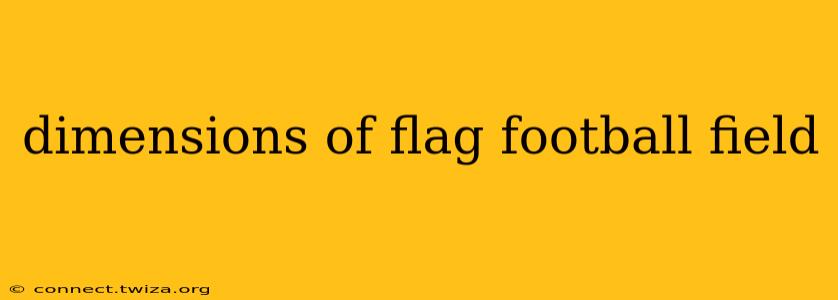Flag football, a popular variation of American football, boasts a simpler, faster-paced game perfect for various age groups and skill levels. Understanding the field dimensions is crucial for players, coaches, and organizers alike. While the exact dimensions can vary slightly depending on the league or organization, this guide provides a clear understanding of the standard measurements and common variations.
What are the standard dimensions of a flag football field?
The standard dimensions of a flag football field closely mirror those of a traditional American football field, but with key differences. Typically, a flag football field is between 40 and 80 yards long and 20 to 40 yards wide. This flexibility accommodates various playing levels, from youth leagues to adult recreational games. The end zones are usually shorter than in traditional football, often ranging from 5 to 10 yards deep.
The most common setup for many adult and high school leagues is a field that's 50 yards long and 30 yards wide, with 10-yard end zones. However, always check the specific rules and regulations of your league to confirm the exact field dimensions.
How wide is a flag football field?
The width of a flag football field, as mentioned above, can vary. However, 30 yards is a very common and widely used width. This offers enough space for players to maneuver while still maintaining a relatively compact playing area.
How long is a flag football field?
The length of a flag football field, too, is flexible. A field 50 yards long is often considered the standard, but leagues might use longer or shorter fields depending on their needs and the age group of players. You'll frequently find fields ranging from 40 yards to as long as 80 yards.
What about the end zones in flag football?
End zones in flag football are typically shorter than in traditional football. You can expect to see end zones ranging from 5 to 10 yards deep. The reduced end zone size contributes to the faster pace of the game.
What are the differences between flag football and tackle football field dimensions?
While flag football fields often borrow dimensions from traditional football, there are key distinctions. Tackle football fields are significantly longer (100 yards plus end zones), and much wider (53.3 yards). The larger size accommodates the more complex gameplay and the greater number of players on the field. The key difference comes down to space; the smaller flag football field accommodates the faster, more open style of play.
Are there variations in flag football field dimensions?
Yes, there is flexibility in flag football field dimensions. You'll find variations depending on the age group, the league's rules, and the available space. Youth leagues often use smaller fields, while adult leagues or more competitive games may use larger fields. Always check your specific league's guidelines before playing.
How are the field markings made?
The markings on a flag football field are typically made using cones, paint, or markers. These markings delineate the field boundaries, end zones, and any other necessary playing area designations. This ensures clear visual cues for players and referees to maintain fair and organized play.
This comprehensive guide provides a clear understanding of the typical dimensions of a flag football field. Remember, always check the specific rules and regulations of your league for the exact measurements. Knowing these dimensions ensures a fair and enjoyable game for everyone involved.
